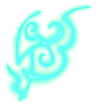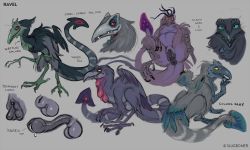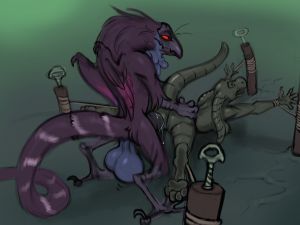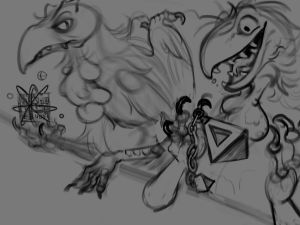 | |
Average height
|
8'-10'
243-304 cm |
|---|---|
Average weight
|
550 lbs
249 kg |
Spawning Myth
| |
When a puzzle is left unsolved
| |
Notable Individuals
| |
An avian species prone to a love of puzzles and paranoid tendencies.
Physiology
Ravels are monstrous corvids. They have a crooked arrangement of sharp teeth, a long, kinked tail, and an assortment of dark and tattered feathers. Both arms and legs are featherless and scaled, and each have four digits ending in a hooked black talon. Most ravels also have fleshy, colorful wattles around their jawline and neck - each individual’s wattle is unique, and is an object of avian vanity.
Ravels tend to have large, toothy beaks, which often appear scuffed or nicked. Their fangs are not a part of the beak itself but rather set into a gumline just within; only the top teeth tend to jut out. A ravel's beak is not flexible enough to be suitable as a means of expression - to a stranger, a ravel may appear to always be smiling, making for sometimes unsettling company. Instead, ravels express mainly with their voice, plumage, posture, and various gestures.
Ravel eyes tend to be large and penetrating with thin reptilian slits, and are adorned with prominent lashes.
While winged, most ravels can't fly without the aid of a spell or technology of some kind. Their wings appear small and vestigial, and are primarily used to emote.
A ravel’s wings and tail fan are usually the most colorful parts of the bird’s plumage, and each coloration is unique to the individual. They tend to be a drab mix of cool colors, such as blues, teals, and purples. Most ravels have a fluffy mantle of longer feathers around their neck, and in some individuals this extends into a feathery mane that tapers down the back. Their feathers often appear a bit oily.
The Wattle
Ravels tend to be proud of the prominent, fleshy flaps that hang from their beak and neck; the more saggy, wrinkled, and bulbous the wattle, the more proud a bird tends to be. Many see fit to adorn these protrusions with jewelry or tattoos. Those insecure about their wattle appearance may seek arcane enhancement, or may practice various methods of wattle-stretching over a period of time to achieve the desired level of sag.
Ravels are largely androgynous in build, though females may have slightly less vibrant plumage and wattles than males; a female's wattle might be slightly smaller as well. Females do not have breasts. A transgender ravel may seek a permanent spell to alter their feather color, though many do this for a variety of other reasons as well.
A ravel's genitalia are mammalian and external. A ravel’s shaft is long and thick with a bulbous knot that makes up the glans. The female has long, prominent labia in a similar color and shape to their wattle.
Ravels lay eggs in clutches of two or three. The eggs are around 6" long, and the shell often denotes the color of the offspring’s wattle.
Stereotypes
Ravels are known problem-solvers. If a ravel doesn't have a problem to solve, it's said to make one - for this reason, puzzle-making is a popular pastime among ravels. Without this or a similar constructive hobby, individuals tend to dissect their circumstances in search of problems, and often in destructive ways.
Some may see ravels as overly paranoid. A ravel tends to be uncomfortable around a new person, place or object until it's been thoroughly investigated. Such investigations generally involve a lot of staring from various angles, poking, plucking, and tapping with hand-talons. A stranger entering the company of many ravels may be crowded around by the entire group, who will then proceed to mutter and croak suspiciously, gingerly touch and tug at the individual until a basic familiarity has been achieved. Noticing strange people or objects is sometimes enough to demand a ravel’s full attention, and this can notoriously interrupt conversations, sex, or anything else in which the individual may have been engaged.
Many individuals of non-ravel species don’t appreciate being looked over or poked at by a bird they’ve never met; as such, ravels are expected to keep their tendencies in check. Most ravels will allow another ravel to investigate them, however. For this reason, some may instead prefer to surround themselves with those of their own kind.
As a stereotype, ravels have an ambling and sometimes needlessly poetic, philosophical or magical way of speaking. Asking one for something mundane is so notoriously fruitless that there exists a phrase in Nodd to describe long-winded responses that don’t answer the question asked - “like asking a ravel for the time”. Some assume ravels to adore shiny trinkets, but a ravel is more likely to be startled by such things, or at least suspicious. This misconception may come from the trend of some ravels to wear shiny jewelry to intimidate others of their kind.
Ravels do most of their expressing with their feathers, wings, and tail. An agitated ravel may “beak wipe” against a nearby surface, such as a bar top or the back of a chair. Ravels are also known for expressing with an impressive range of vocalizations. Anywhere with a number of excited ravels is sure to be a raucous affair.
Image Gallery
-
A ravel partaking of a splayed citizen
-
Two ravels creating puzzles of varying difficulty






